
views
Defining Your Business

Find your niche. Decide specifically what kind of furniture you will create, such as home furnishings, office furniture or cabinetry. Specify the materials you intend to use, such as wood, metal and upholstery. Identify your target market. For example, decide if you will sell to residential, resort or commercial customers. Also, determine if you will sell only locally or if you will reach out to a broader market. Perform a market analysis to assess the demand for your furniture. Identify your target market and their distinguishing characteristics and needs. Also, look at your competitors to find out what they don't offer. This will tell you if your product fills a gap in the market. Finally, a market analysis studies appropriate pricing for your product and your target market.

Opt for a brick and mortar store or an online business. You may choose to rent a store front with a workshop and sell your furniture to walk-in customers. Alternatively, you might choose to develop a website and take only online orders. Or, you may choose to do both. Whichever option you choose impacts your decision about the physical location of your business. Also, it impacts the amount of money you need to start your business.
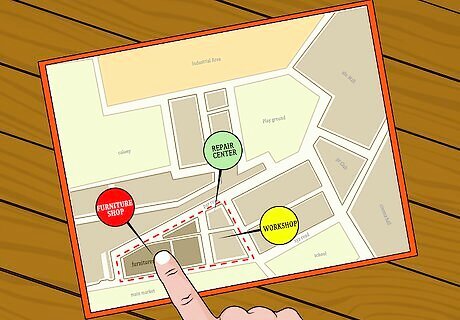
Choose a location. If you plan to open a physical store, find a space that suits your customers' needs. For example, if you are making custom cabinets, find a space that's large enough to display different options. Or, if your target market is residential, choose a space that's easy to find and accommodates parents with children and strollers. Also, consider your suppliers. Find a location to which your suppliers can easily ship. Research zoning laws and regulations in your area to determine where you are permitted to run your business. If you are going to do all of your business online, then you still need to find a location for your workshop. Find a space that's big enough to complete your work efficiently and that's convenient for your suppliers. Depending on the type of materials you need to keep on hand, you may also need a warehouse space. Choose one that is large enough for suppliers to easily pick up and drop off materials. Don't choose your location based on the most affordable rent. Rather, choose the best location you can afford that attractively displays your furniture and efficiently accommodates your customers.

Structure your business. Choose a business structure for your business, such as a corporation, partnership or sole proprietorship. The business structure you choose affects how you file your income taxes. Consult a certified public accountant (CPA), lawyer or other business advisor to help you make this decision. Register your business with the Secretary of State in the state where you plan to do business. Obtain a federal tax identification number from the IRS, and check in with your state to determine if you need a state tax identification number.

Obtain licenses and permits. Every state requires some form of business or license to operate legally in that state. Visit the website of your state government to research what is required to open your furniture business in your state. Your state may have specific regulations about the location of your furniture making business. Also, familiarize yourself with state and federal consumer safety regulations. Furniture manufacturers must comply with requirements regarding formaldehyde emissions from wood, greenhouse gas reporting, hazardous air pollutants from wood and metal coatings and hazardous waste disposal.

Write a business plan. Every entrepreneur should invest time in writing a business plan. It commits your ideas and plans to writing and provides a road map to success. Often, woodworkers see themselves as artists devoted to their craft. As such, developing sound business practices may not come naturally to them. Further, they may view time devoted to business practices as detracting from the quality of their work. However, if you want your furniture-making business to be successful, you must invest time defining your marketing strategies, developing financial projections and organizing and managing your business. Write a company description that explains the kind of furniture you make, how you make it, how you're different from your competition and who you target customer is. Explain your market analysis. Describe how you have researched other furniture manufacturers and how your business fills a need in the market. Define your business structure, such as a sole proprietorship, partnership or corporation. This decision has important tax ramifications. Describe your product line, such as exactly what kinds of furniture you manufacture, what materials you use and how it benefits your customers. Explain how you plan to market your furniture business. This includes not only how you plan to advertise, but also how you plan to grow your business with new products or expansion into new markets. Supply financial projections for the next five years. This is especially important if you plan to finance some of your startup costs. Creditors will want to see your financial projections.
Funding the Startup
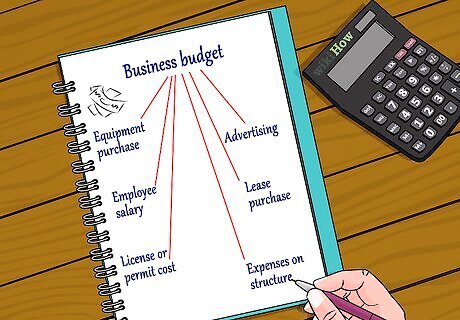
Forecast your start-up expenses. Accurately budgeting your start-up is crucial to making your business successful. Precisely itemizing your start-up expenses makes it easier to communicate with banks and find investors. Also, it helps you to correctly forecast your profitability in the first year of your business, which has tax ramifications. Finally, your start-up expenses and any debt you incur become part of you financial projections for your business plan. Start-up expenses may differ from business to business, but include the following categories. Expenses for structuring your business. If you have to consult a CPA or lawyer, include those expenses. Include fees for registering your business with your state and for obtaining your tax identification number with the IRS. Cost of obtaining licenses and permits and for complying with state and federal safety and environmental regulations. Purchase or lease of your business location. Purchase or lease of equipment. Purchase of start-up inventory. Before you ever make a sale, you will need to purchase materials such as wood, glass, metal and textiles to make your initial pieces of furniture. Advertising and marketing expenses. Wages and benefits for your employees.

Plan to acquire high-quality equipment. Whether you've been doing woodworking as a hobby in your home or have worked in a more commercial setting, you probably already own some equipment. However, if you plan to grow your business by offering new products or getting into a new market, you may need to upgrade your equipment. Don't waste time and money rigging your already-existing equipment to make new pieces. For example, Tom Dolese of Terra Firma Design in Bellingham, WA states that his investment in a horizontal mortise allowed him to do complicated joinery precisely and efficiently.

Find funding sources. Choose from a variety of methods for funding your business. You may have enough in personal savings to invest in your business. Or, you might have friends, family or other business associates who would be willing to invest in your furniture making store. You would either make plans to pay back their loan or offer them a share in your company, depending on your business structure. Finally, you can finance your business with a loan. The Small Business Administration (SBA) partners with banks and lending institutions to offer loans to help business owners. Other funding sources include a personal line of credit from your bank, peer-to-peer lending sites like Prosper, tapping into your retirement account, using credit cards, getting a home equity loan or using a crowdfunding site like Kickstarter or GoFundMe.
Setting Up Your Shop

Equip your shop with woodworking hand tools. Building fine furniture requires a number of hand tools for completing detail work. They can be expensive, so it's daunting to think about investing in a lot of different hand tools. Begin by purchasing these essential hand tools for woodworking. A bevel-up, low-angle jack plane is a versatile tool to smooth and shape wood. A block plan for planning across the end grain of wood. A small 7- or 8-ounce Japanese plane hammer for common finishing tasks like driving in finishing nails. Bevel-edge chisels for chopping mortises by hand. Water stones for sharpening tools. A 3-inch engineer's square for laying out joinery. A pocket square for frequent measurements like checking thickness. A 12-inch combination square for a straight edge or for finding a 45-degree angle. A wheel marking gauge for making reference marks. A 6-inch sliding bevel gauge for doing work with angles. A card scraper for sanding tricky areas like curved parts. A mill-bastard file for shaping and sharpening.

Purchase or lease furniture-making machinery. Obtain the basic machinery first. Once you have that on hand, consider any special equipment you need to make your manufacturing process more efficient. A band saw for cutting angled or curved shapes. A disc sander for sanding the end grain of timber. A drop saw for cutting timber. A finisher for sanding the edges and faces of timber. A mortising machine for drilling out square mortise holes. A pedestal drill for accurate drilling on large materials. A scroll saw for cutting small, thin pieces of timber. A table saw for cutting large pieces of timber or manufactured boards. A thicknesser for smoothing rough timber and reducing its thickness.
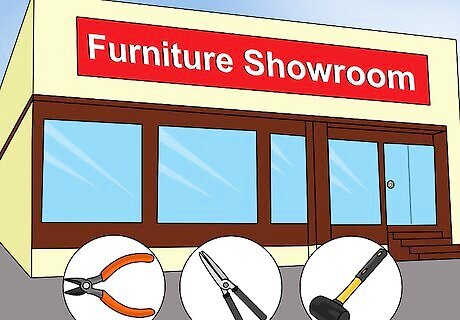
Obtain upholstery tools and equipment if necessary. Professional upholstery requires a combination of hand tools and pneumatic tools. Invest in top quality tools that will make your upholstered pieces look their best. In addition to professional tools, purchase useful items from the hardware store, such as: wire cutters for pulling out staples; a framer's square for straight cuts on fabric; a 45- or 60-inch ruler; and a utility knife for removing old fabric. A magnetic tack hammer for easily picking up tacks and attaching them to furniture. A webbing stretcher for pulling webbing close to the frame. A regulator for adjusting cushion filling through fabric. A rubber mallet for installing tack strips without marring the surface. Upholstery shears for cutting fabric. Assorted curved needles for hand sewing. A 10-inch button needle for installing buttons through pillows, cushions and furniture backs. Upholsterer and “T” pins for holding fabric during hand sewing. A hand-held staple gun or a pneumatic upholstery stapler. An upholstery button machine for making buttons. An upholstery foam cutter.
Marketing Your Furniture

Create a website. Even if you don't sell your furniture online, you should have a high-quality website to showcase your work. Invest in a web designer to make your website look professional. Update your website regularly with new pieces. Consider adding a blog page with posts about project updates, your design process and tips for shoppers. Have a professional photographer photograph your work and post these images on your website. The better your photographs are, the more appealing your work will be to prospective customers.
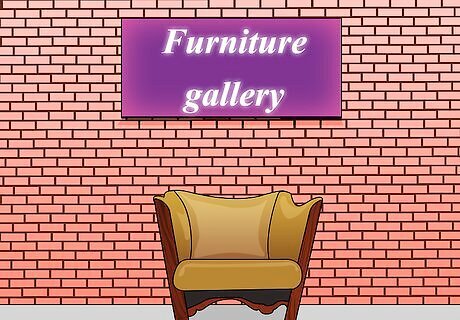
Become affiliated with galleries. A gallery will display your furniture as artwork. This allows a broader base of customers to become familiar with your work and see it first-hand. Customers can purchase pieces directly from the gallery. In this case, the gallery keeps a portion of the sale. Tom Dolese of Terra Firma Design credits his relationship with the Northwest Woodworkers Gallery in Seattle for expanding his business from his small town in northern Washington to include many customers in Seattle.

Expand your product line. Attend woodworking classes to learn cutting edge and different techniques. Incorporate your new skills into your work. Dedicate time to coming up with new designs. Collaborate with other colleagues and share ideas and expertise. This allows everyone to grow and learn from each other.
Incorporating the Fundamentals of Furniture Design

Find inspiration for your designs. Inspiration comes from many places. For example, the natural world is full of shadows, forms and silhouettes that can turn into the basis of shape, line and colors for your design. Also, everyday items such windows, food or buildings can inspire ideas for cabinetry, table legs and other furniture elements. Of course, always be inspired by the needs of your customers. Consider how the furniture will be used when determining materials and structure. Also, think about the design aesthetic of your brand. For example, your design style can be contemporary, traditional, country or Victorian.

Create contrast. Contrast is the pairing of opposites, such as light and dark or rough and smooth textures to generate visual interest or depth. It can also be used to highlight an important element of a piece of furniture. For example, if the doors on your cabinet feature a signature design element, craft them from a different wood or change the direction of the wood to draw the eye to it. Contrast can be subtle or more obvious, but it should not be overused. Avoid severe, distracting contrast in your pieces. Rather, opt for artful playfulness.

Consider proportion. Proportion refers to the size and scale of the components of the piece. In addition to size, it also has to do with creating harmony among the colors, shapes and textures. The way that these elements should relate to each other depends on your cultural experience. The eye becomes accustomed to seeing a desirable proportion among elements in nature, especially on the human body. In fact, you probably don't even think about proportion until you see something that looks out of proportion. The Golden Rectangle is a symmetrical relationship that has been used in design for thousands of years and by famous artists such as Salvador Dali, Leonardo da Vinci and the designers of the Parthenon. It is a mathematical concept that makes visual designs more appealing. It is derived from the Fibonacci sequence which is found everywhere in nature, from leaves, to seashells and even the human face. The proportion of the Golden Rectangle is 1:1.618.
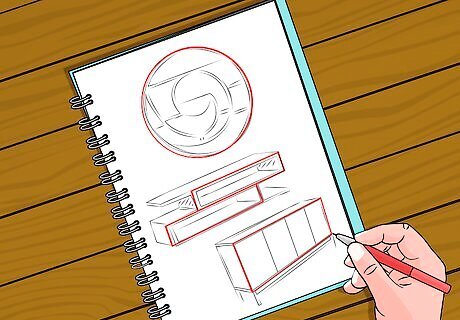
Determine shape. Shape is also known as form. It is determined by the outline of the piece. Three basic types of shape in furniture are geometric, organic and abstract. Geometric shapes include circles, squares, rectangles and triangles. They are make from straight lines and curves and are often symmetrical. Organic shapes are often asymmetrical and mimic objects found nature, such as leaves or bodies of water. Abstract shapes are artistic representations of forms which may or may not be recognizable.

Look at the relationship between the lines. Lines on a furniture define the space and guide the eye around the piece. Depending on the design style, they can be straight or curved, thin or thick, vertical or diagonal. Examine the lines in your pieces to evaluate how they align. Horizontal lines add length and width to a piece. The combination of vertical and horizontal lines add symmetry and balance. Curved lines create movement and add whimsy.

Add texture and patterns. Texture is the quality of the surface of the material. Texture can be visual, such as how a piece absorbs or reflects light. It can also be tactile, such as the feeling of fabric on a chair. Patterns are created by the repetition of elements in a piece. You can add pattern with shape, color and texture.
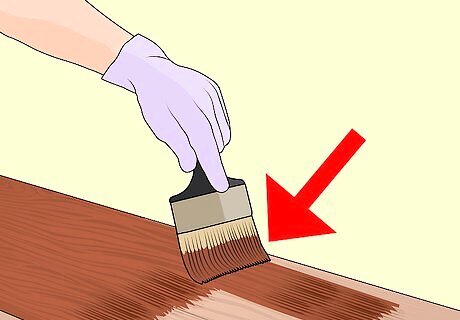
Introduce color. When using color, consider its three qualities: hue, value and intensity. In addition, colors can also be described as warm or cool. Color can be added to furniture with paint, stain and textiles or by using different kinds of wood. Hue is the name of the color, such as red, yellow or blue. Value is how light or dark the color is. Light colors can sometimes make furniture appear unstable, whereas dark colors add visual weight. Intensity refers to how bright or dull the color is. In general, warm colors are red, yellow and orange, and cool colors are blue, green and violet.




















Comments
0 comment